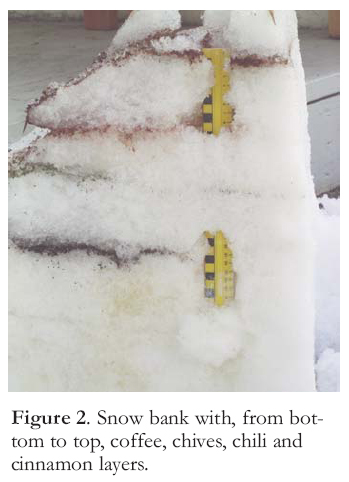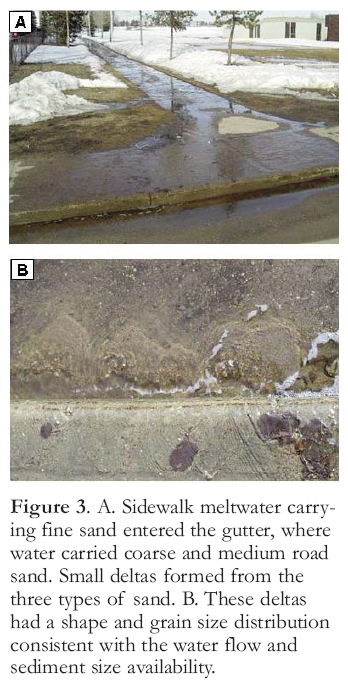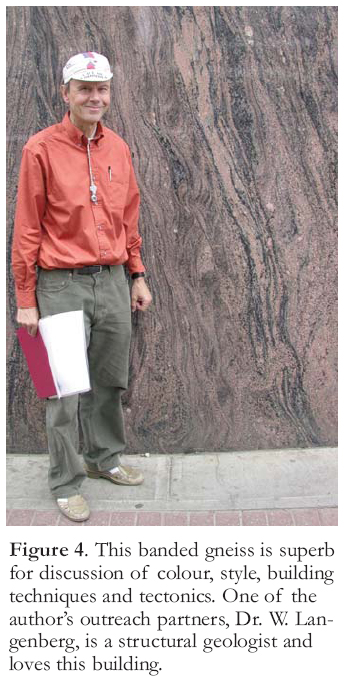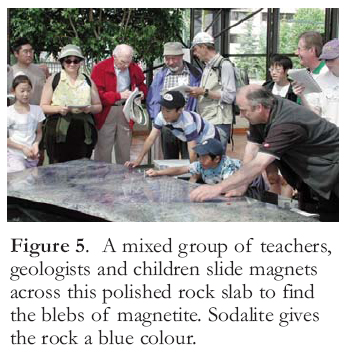Articles
Using the Geology of Your Neighbourhood and City for Geoscience Outreach
W.A. Dixon EdwardsAlberta Geological Survey (retired), Alberta Energy Resources Conservation Board, 4999-98 Avenue, Edmonton, AB, Canada, T6B 2X3
DixonEd@shaw.ca
SUMMARY
Most Canadians live, work and attend school in urban areas. Your neighbour-hood has wonders such as snow-bank stratigraphy, sidewalk sedimentology, and building stone. Urban fieldtrips require little money and little time to run and they can inspire participants. An inner-city school teacher confirmed my belief in urban fieldtrips when she said, “I’ve never been able to take my students anywhere but we can now take a city bus downtown and see the world. Thank You!” So open your eyes to the grand world of geology around you. Take others on a neighbourhood trip; you will inspire, motivate and educate them.SOMMAIRE
La majorité des Canadiens vivent, travaillent et étudient en milieu urbain. Votre voisinage même offre des occasions d’émerveillement comme des exemples de stratigraphie de bancs de neige, de sédimentologie des trottoirs, et de pierres de construction. Les excursions urbaines sont peu coûteuses, prennent peu de temps et peu-vent s’avérer stimulantes pour leurs participants. Une enseignante d’une école en milieu urbain a confirmé mes idées sur les excursions urbaines lorsqu’elle a déclaré, « Je n’avais jamais pu sortir mes élèves, mais maintenant, nous pouvons prendre l’autobus et voir le monde, grâce à vous. » Soyez donc à l’affût de l’univers géologique qui pointe dans votre milieu. Amener les gens de votre entourage en excursion; vous les aurez intéressés, motivés et éduqués.INTRODUCTION: YOU CAN INSPIRE INTEREST IN GEOLOGY
1 Most geologists find the study of geology stimulating and a consuming livelihood. Why should you take time away from your career to get involved in outreach? Think back to the event or person that first inspired your interest in geology. I was enthused over finding red (garnet) and black (magnetite) bands on the Lake Ontario beach near my home when I was four. I was curious about the lumps of coal I unearthed in my backyard when I was eight. With no one to share and encourage my discoveries, these events lay dormant in my mind until, accidentally, I enrolled in a first year geology class taught by Peter Peach at Brock University. Through his stories he turned geology into mysteries. He rekindled in me that creative desire to understand the world around me. My outreach activities keep this thrill of discovery alive and fresh for me; every twinkle in a child’s eye or slow smile of recognition in a senior brings a visceral satisfaction. If you enjoy encouraging a child’s interest in the pebble they found, motivating a teacher to tell their class about geology, or arousing the curiosity of a senior about the world at their doorstep, then you will relate to why and how I put outreach into practice. Take the time to feel good, try a small outreach activity. If you feel good about the activity then you will inspire, motivate and educate.
LACK OF MONEY, LOCATION, TIME OR SPECIALIZATION IS NO OBSTACLE
2 People seem impressed by the incredible places and extraordinary events that were part of my job as a professional geologist: commanding a helicopter, finding gold, watching the sun set over an unspoiled lake or getting stalked by a timber wolf. Of course, it cost my company a lot of money and resources to get me to these places and to keep me there long enough for that timber wolf to find me. If you have the resources and time to take groups or classrooms into the wilds for an extended period it would be an incredible experience. On a handful of occasions I was able to take groups of a dozen teachers through the mountains for intensive, week-long fieldtrips during the summer. These trips required budgetary support from EdGEO, a registration cost to each teacher of over $300, and major support from my organization for my time in preparing and delivering the workshops. I have also led hundreds of people, including teachers, geologists, government workers, and seniors, on urban fieldtrips (walks) ranging from one to four hours, at a cost of bus fare and a half day of my time for preparation.
3 Participants on my long road trips and urban fieldtrips were asked to complete evaluation forms. In perusing them I noticed similarities beyond the normal ‘wonderful experience’ and ‘very educational’ responses you get for any volunteer activity. Certain things elicited recurring, amazed and specific comments from participants, e.g. going behind the scenes at the Tyrrell Museum, seeing large fossils in building stone, and panning gold from the North Saskatchewan River in downtown Edmonton. As an organizer and leader of geological fieldtrips, it can be disconcerting to realize that the things that inspire people may be right around the corner. Sometimes, a seemingly small effort can be nearly as positive as a major activity and the little trips can reach, literally, hundreds more individuals at a tiny fraction of the cost. You can run an inspiring workshop with little money, limited time, and right in your own backyard (Fig. 1).
4 Some geologists are reluctant to lead a fieldtrip or workshop because it may cover topics they have not studied since they were at university. Over my thirty years of public lectures, workshops and fieldtrips, questions were posed that I could not answer, but in only one instance did a participant know much more about the topic. He was a grade three student in my son’s class whose granddad operated a rhodochrosite quarry. This eight year-old expert kindly described the mineral for us and presented me with a polished specimen that I have to this day. I have had the pleasure of receiving assistance from professional experts in paleontology, mineralogy, structural geology and stratigraphy on some of my fieldtrips. Although it was reassuring for me to know that the information delivered was accurate and cutting edge, I sometimes found myself acting as translator between the specialist and the group. As leader, I had formed a bond with many of the participants that depended more on my ability to communicate at an appropriate level than on my qualifications. It was also apparent that participants were more often inspired through observation and activity than by a lecture; for example, I knew that they really recognized gold flakes or saw a pattern take form as a fossil when their faces would break into smiles and they would grab their partner to pass on their discovery.
Figure 1. The obvious geological features of Edmonton are the North Saskatchewan River (gold, landslides, outcrop) and the buildings (building stones from around the world).GEOLOGY FOR EVERY CANADIAN
5 Most Canadians live, work and attend school in urban areas, and, except for an occasional foray into the wilderness, this is my environment as well. Some years ago I would walk my dog, Sammy, through my neighbourhood in Edmonton. Sammy did not walk fast, so I began to notice geological features and processes. Many of these were ephemeral so that there was always something new to see. Winter and spring hold some special geological treats. It is a great time for public education because this is often considered off-season for work and activities in the natural environment by both geologists and teachers.
6 Before Sammy took me for walks, I thought people had to travel to observe geology. Now I realize that geology is alive and well right here in my neighbourhood and city. It surprised me to learn that many of my geological colleagues never noticed the stone in the buildings they walked by daily and had never panned gold from the North Saskatchewan River only six blocks from our office. I guarantee you will find geological wonders in your city. Following are some of my neigh-bourhood favourites.
Geology in your Neighbourhood
7 Did you ever notice the layers in natural snow banks and speculate on how these relate to specific events? A snow bank is an effective way to explain and illustrate stratigraphy and time; it presents an opportunity to run long or short, natural or artificial experiments. Figure 2 shows the snow bank I built behind my deck. At the end of each snowfall or load of snow, I spread a common colourful material over the surface: I used ground coffee and cinnamon, dried chives and chili powder. I recorded the date and time each powder layer was deposited. At the end of the experiment I cut a core into the snow bank, and then cut the snow bank in half. In both the core and the section I observe the stratigraphy and was able to create a time scale. Sammy helped me discover an outreach bonus, snow-bank tectonics. A few days after cutting into the snow bank, I discovered a block containing layers lying at the base. It either fell naturally or Sammy jumped on the snow bank and dislodged it. I was able to correlate the layers in the block with the snow bank. I recognized that the block was overturned and reconstructed the motion of the block.
Figure 2. Snow bank with, from bottom to top, coffee, chives, chili and cinnamon layers.

Display large image of Figure 2
8 The spring is a wonderful time to observe miniature fluvial features formed by running water released from melting snow. Over a week I observed small deltas form in a gutter where meltwater flowing down a sidewalk cascaded over the curb. Upon close inspection I observed that the deltas seemed to have a characteristic shape and sediment distribution: the plunge-pool had the coarsest sand, the delta top and mid-face exhibited the finest sand, and the delta toe contained an intermediate size (Figs. 3A, B). Curiosity and the challenge of a mystery got the better of me. What was the source of the sand? I sampled the parts of the delta, a miniature channel bar up the road (upstream) from the deltas, as well as ripplemarks on the sidewalk. My sampling confirmed my observations; there were three specific sizes of sand in the deltas and the toe had a bimodal distribution. The medium sand also was found in the bar up the road and correlated well with the sand spread by the city on the streets. Coarse sand was applied at the icy intersection just upstream from the deltas. Fine sand was used on the sidewalk, formed the ripplemarks there, and was carried by water down and into the deltas. The sand in the deltas had a three-fold source, mystery solved.
9 Snow bank stratigraphy, sidewalk sedimentology and dozens of other processes and features found in the neighbourhood probably would not inspire a senior citizen but it may be just the thing to arouse the curiosity and inspire a grade school student, especially if the experiment takes place right outside their home or school.
Geology Downtown
10 In the 1990s, I was asked to help with the development of the geology section of a new Grade 7 textbook. The editors were largely unaware of geological examples from Alberta and were struggling to provide society-science examples as part of the Science-Technology-Society (STS) model they were using. Fortunately, as an industrial minerals geologist, I live an STS life (discover a deposit, mine and process it, and make a product for society). At that time I recognized a proverbial gold-mine for my urban outreach field-trips: building stone.
11 At a single intersection in downtown Edmonton (101 St. and Jasper Ave.) we can observe sedimentary, igneous and metamorphic rocks. The stone that enthralls almost everyone is the Tyndall Limestone, which contains a plethora of large fossils. The igneous rock in the Empire Building contains very large, zoned feldspar crystals and a third corner contains spectacular banded gneiss from Minnesota (Fig. 4). Within two blocks of this intersection we can see a beautiful polished slab of sodalite with blebs of magnetite that can stop a speeding magnet (Fig. 5) and several examples of Indiana Limestone that even some geologists assume, at first glance, to be artificial. Indiana Limestone is the stone used for the carvings we see in a number of downtown Edmonton buildings.
Figure 3. A. Sidewalk meltwater carrying fine sand entered the gutter, where water carried coarse and medium road sand. Small deltas formed from the three types of sand. B. These deltas had a shape and grain size distribution consistent with the water flow and sediment size availability.

Display large image of Figure 3

Display large image of Figure 4

Display large image of Figure 5
12 This menagerie never fails to excite the group. Someone almost always says they will never walk by a building again without noticing the stone. I have had requests for tours for teachers’ conferences and seniors groups and even geologists. A building stone walk is a wonderful resource to supplement rock, mineral and fossil workshops. Building-stone tours are excellent for busy people; I have led effective tours in as little as forty-five minutes and they can even be done inside downtown malls. The stone provides a connection to the building itself and a link to history and architecture that in itself is of interest to many people and provides another dimension. One comment I received from a teacher at an inner-city school confirmed my belief in urban fieldtrips and made my effort worthwhile: “I’ve never been able to take my students anywhere but we can now take a city bus downtown and see the world. Thank You!”
Special Geology in your Town
13 Every city or town across Canada will contain or be near a geological feature that makes it special. It may be a rock outcrop, a beach, fossils, or in the case of Edmonton, a river filled with gold. For many years I have taken groups of teachers, geologists, friends or family down to Emily Murphy Park in the heart of Edmonton to help them pan gold (Fig. 6). I absolutely guarantee them gold. They look very sceptical. In about a minute I pan down a shovel full of gravel and show them the gold flakes. Now I have their undivided attention. I demonstrate how to pan, give them a pan and turn them loose. After that we begin to work our way through their small case of gold fever.
14 Depending on the time we have available for the workshop we can collect the gold (plus garnet and magnetite) in a small vial using a snuffer bottle and a magnet and even look at the beautiful little mineral grains under a lens or microscope. It is a great opportunity to describe the specific gravity of minerals, how this makes gold panning possible, the origin of the various minerals and their use while we are having a picnic lunch.
15 Edmonton has a long history of gold prospecting and production. Prospectors discovered placer gold in the sand and gravel of the North Saskatchewan River in the mid-1800s. By the turn of the century there was an active industry in the Edmonton area that included as many as a dozen large dredges. In fact, we still have commercial production of placer gold as a by-product of the gravel mining operations just northwest of Edmonton. Every spring flood brings a new layer of flour gold and amateur prospectors and recreational gold panners always strike it rich.
Figure 6. A. The author explains to a group of planners and environmentalists how to pan gold. B. A typical pan with lots of magnetite, garnet and quartz and anywhere from 10 to 125 flakes of gold.

Display large image of Figure 6
16 Placer gold was one of my research topics at the Alberta Geological Survey, so the technical aspects of panning and the geology surrounding it are easy for me to describe. But, you do not have to be an expert to demonstrate gold panning. My father came for a visit when he was 75 and I took him panning for the first time at Emily Murphy Park. In a matter of minutes he was hooked and happily started to pan on his own. When I turned around a half hour later, he was explaining to some ‘tourists’ how you pan gold and showing them his gold flakes. As they walked away I overheard one of the couples commenting how fortunate it was to run into an old prospector who could tell them all about the placer gold. With enthusiasm, confidence and a smidgeon of knowledge, you can instruct and encourage others.
GETTING STARTED
17 It is easy to get started on a local out-reach project. Take a walk through your neighbourhood or downtown, along the river, by the shore or across a park. Keep your eyes open and look for geological wonders. When you see them, and you will, take some notes and photos. Think about the site or process and perhaps check for literature that can provide background. If the site is open to collecting, you may even do your own investigation.
18 The site may be interesting enough to be the focus of a single visit or workshop, or you may put a number of sites together as a walk or tour. Choose a broader geological process or topic that is illustrated at the site or sites, and you have an outreach or public education activity.
19 You can gauge the potential interest in the activity by monitoring the enthusiasm of your friends or family when you take them to the site or on the walk. When you are confident about your activity, approach the principal or teacher at a local school, a science consultant in the school system, a scout leader or anyone else that is a contact for a group ripe to learn about geology!
20 You will have a readily available fieldtrip site. You will be an instant expert. You will discover others interested in the topic and find that there are support groups (CGEN and local geological societies) and even grants available for materials (EdGEO). You will feel good about your activity. You will inspire, motivate and educate. All because you took a walk with your dog and opened your eyes to the wonderful world of geology that is around us all.
